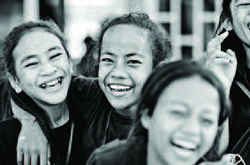 Adolescents with HIV in Phnom Penh, Cambodia. Photo: Kevin TachmanSurvival of children with HIV has greatly improved due to expanded access to antiretroviral therapy (ART) around the world. A recent study from the TREAT Asia Pediatric HIV Observational Database (TApHOD) described the HIV treatment outcomes of a regional cohort of Asian adolescents who acquired their infection at birth or during early childhood.1
Adolescents with HIV in Phnom Penh, Cambodia. Photo: Kevin TachmanSurvival of children with HIV has greatly improved due to expanded access to antiretroviral therapy (ART) around the world. A recent study from the TREAT Asia Pediatric HIV Observational Database (TApHOD) described the HIV treatment outcomes of a regional cohort of Asian adolescents who acquired their infection at birth or during early childhood.1
A total of 1,254 adolescents aged 12 years or older from 18 pediatric clinics in six Asian countries were included in the analysis. More than two-thirds were from Thailand, 47% were male, and 95% had ever received ART. As of March 2011, 85% of the adolescents were under active follow- up, 8.6% had been transferred to other clinics, 4.1% had been lost to follow-up, and 2.6% had died.
Those still in follow-up and on treatment had been taking ART for a median of six years, and 85% were still on their first-line regimens. Their most recent median CD4 cell count was 657 cells/mm3, and of the adolescents with an HIV viral load test, 86% had suppressed virus levels of <400 copies/ml. Among those still being cared for in TREAT Asia network clinical centers, 73% had lost one or both parents, 62% knew about their own HIV status, and 93% were attending school.
Of the 33 adolescents who died during the time period covered in the study, the median age at death was 15 years, and 31 (94%) were receiving ART at the time of their death. Forty- five percent were reported to have died due to opportunistic infections and 27% due to noninfectious AIDS-related conditions such as renal failure.
Compared to those who died, adolescents who remained in follow-up started their HIV treatment at younger ages and at higher median CD4 percentages (7% vs. 3%). In addition, adolescents who had CD4 levels <200 cells/mm3 at age 12 were about 17 times more likely to die than those who had levels ≥500 cells/mm3.
The researchers concluded that starting treatment earlier and maintaining higher CD4 levels throughout childhood lowered the risk of death among those who survived to adolescence. This study demonstrates that our ability to successfully initiate treatment in children with HIV today directly impacts their future as they age into adolescence and adulthood.
- Chokephaibulkit K, Kariminia A, Oberdorfer P, Nallusamy R, Bunupuradah T, Hansudewechakul R, Khanhdung KT, Saphonn V, Kumarasamy N, Lumbiganon P, Viet DC, Kurniati N, Yusoff NK, Razali K, Fong SM, Khanh TH, Wati DK, Sohn AH. Characteriz- ing HIV Manifestations and Treatment Outcomes of Perinatal- ly Infected Adolescents in Asia. The Pediatric Infectious Disease Journal. [Published ahead of print]